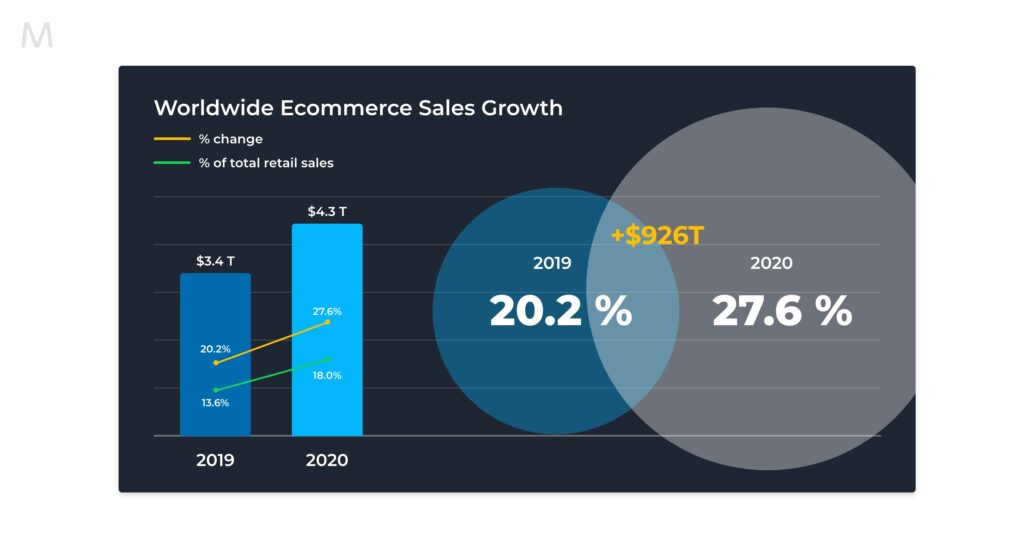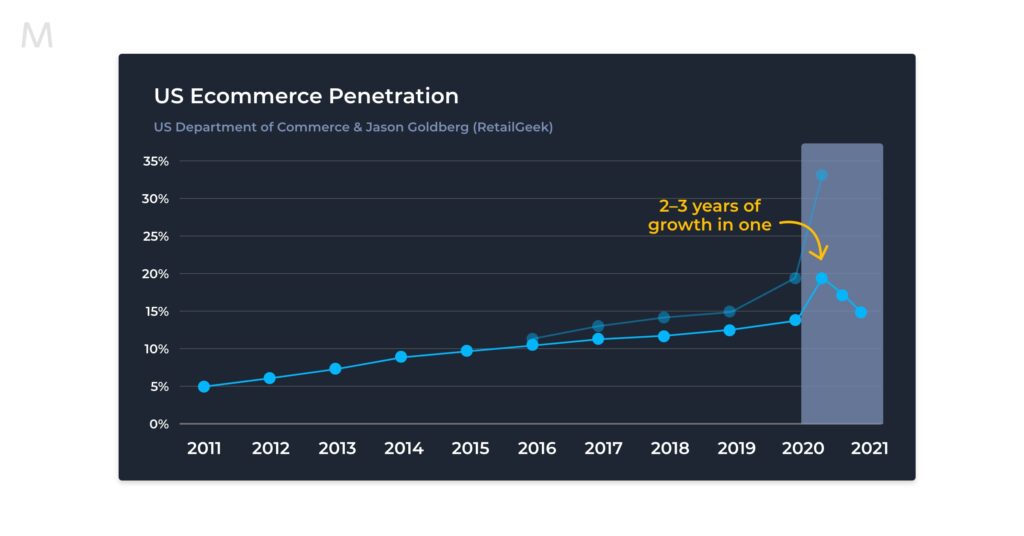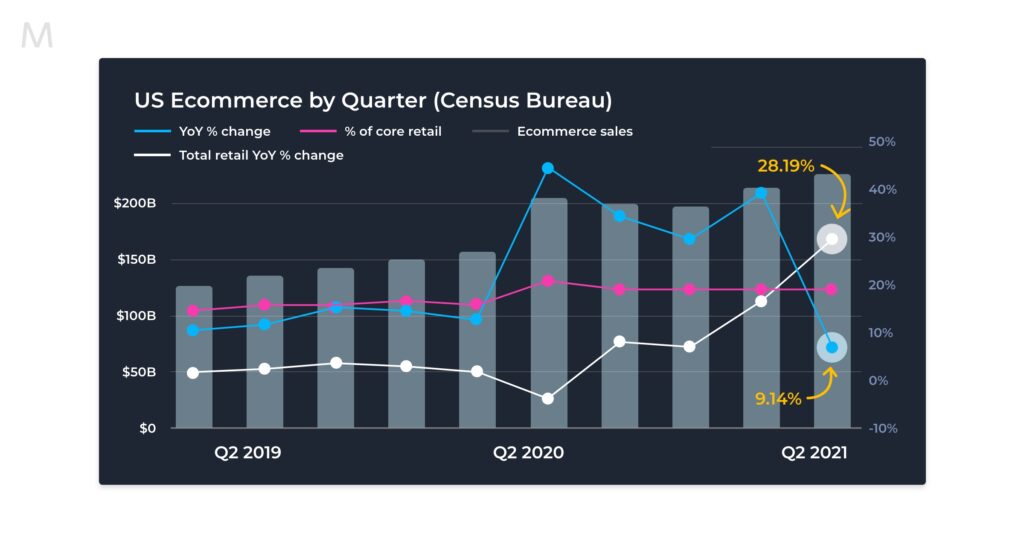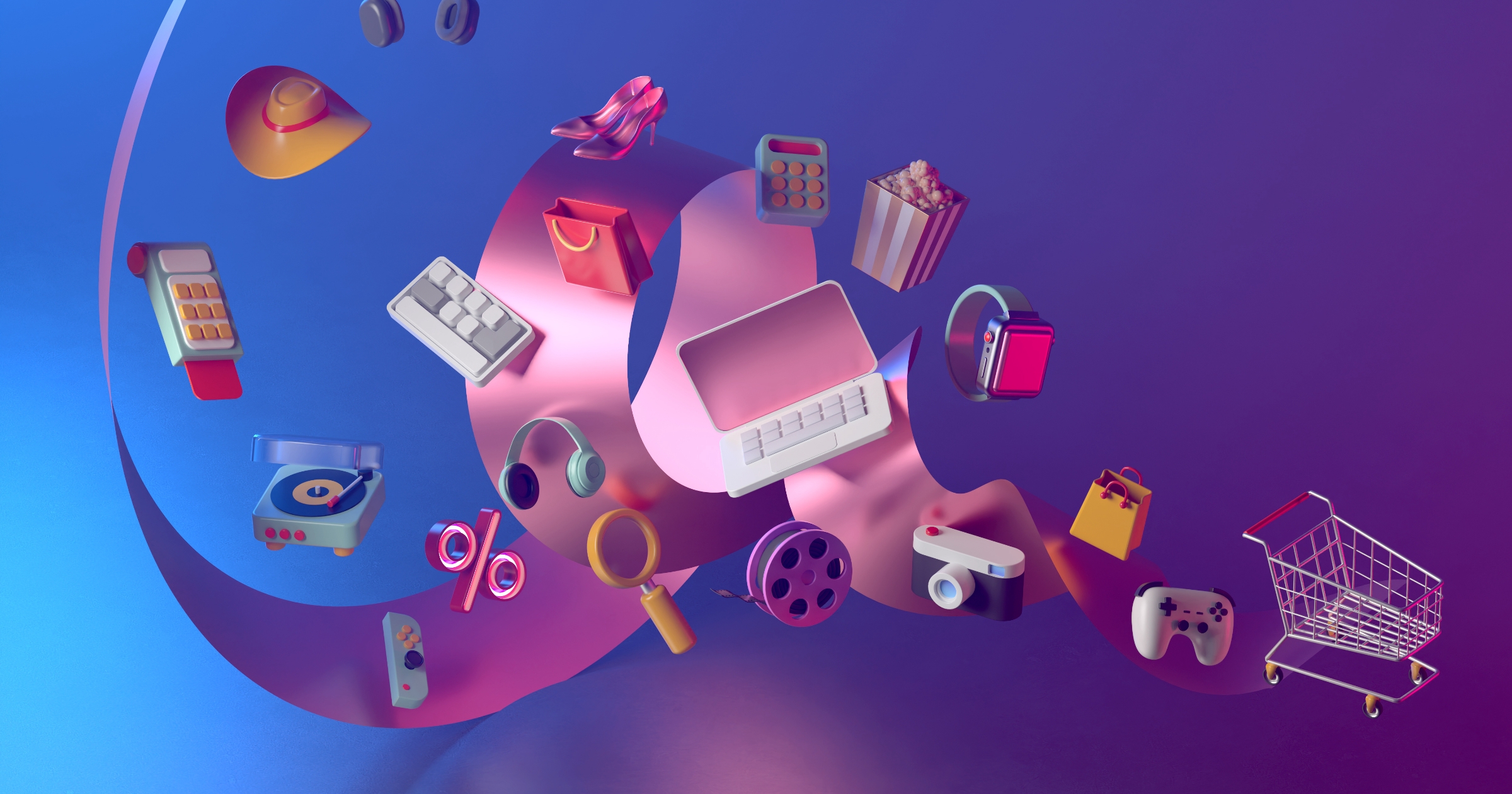The content of this blog is based on a speech by Taylor Holiday, Managing Partner of Common Thread Collective at the Traffic & Conversion Summit 2021.
Many would agree: the first week after we all went into a lockdown back in 2020 was one of the most challenging ones. We had no idea what to expect. It’s safe to say that many marketers panicked. But haven’t we pulled through?
In reality, the commerce space saw major growth. Ecommerce exploded while the rest of the world shut down. Global ecommerce grew by almost a trillion dollars in 12 months. Every negative thing that we feared actually happened the other way around.

This momentum that many of our clients and ecommerce companies around the world experienced is a true testament of what we’re all capable of. And here’s how you can keep this going – read on!
Ecommerce Evolution
You’ve seen this stat before – ”in ecommerce, we’ve fast forwarded 10 years in a matter of 3 months”. For about a year, ecommerce was the absolute leader but…what about now?
Since then…
- Many commerce businesses players have shared with us that many inventory, supply chain and other issues have come up
- As certain parts of the world are a bit more open than before, ecommerce is no longer the only option
- Mail Privacy Protection, aka iOS15 update, has a tremendous effect on what we do and how we do it now
We’re all in a very different reality just a few years later. Turns out that, since 2020, we’ve moved back to the same linear progression path we were on before.

Furthermore, we’re seeing a major shift back to retail. Turns out that, for many ecommerce businesses in 2021 and 2022 “flat” is a great growth outcome.

Here’s where we want to hit “pause” and remind you of a great quote by Cy Wakeman: “Your circumstances are not the reason you can’t succeed. They are the reality in which you must succeed”.

Tips for Thriving
Now that you’re a little less discouraged, how would you like to build a business that can prosper regardless of the environment it’s in?
Here’s a few tips from Taylor Holiday from Common Thread Collective.

It turns out that these points work both at the time when this was written (August of 2020) and now – when our commerce landscape looks very different. Here’s what Taylor calls an anti-fragile ecommerce playbook:
- Fast lead times (< 4 weeks)
- Preferential terms with suppliers (Net 30+)
- Low OpEx (<25% of revenue)
- High margin (> 70%)
- Diverse traffic mix (50:50 paid:organic)
- Strong LTV (40% increase in 60 days)
Let’s define and explore each of these.
Lead Times
A lead time is a length between placing an order to receiving stock that’s ready to sell and ship.
Think about it: if you have to order a product 6-12 weeks in advance, do you know what it requires of you? You become trapped in something that’s fundamentally impossible to do – forecast accurately. The further out you have to forecast your ecommerce business, the wider the error bars are on that forecast. When the past isn’t like the future, how can your forecast be accurate?
Let’s get back to COVID – what data inputs would’ve given you outputs that predicted the global pandemic? And how about iOS15 – which data inputs could you use to forecast that? They don’t exist. So the flexibility to reduce those lead times is your superpower.
The gold standard is – you don’t have to produce a product unless someone orders it. That’s why print on demand is so successful for example. Of course, if you sell things like furniture, you can’t possibly only sell on demand. But then the question becomes – what can you do? Take this as an opportunity to change and adapt.
Supplier Terms

This refers to the time between ordering inventory and paying for that order, along with the percentage of order cost to be paid. In other words, here’s the idea of the cash conversion cycle: how does it take from the time that you place a dollar out to purchase a product before you can sell it and turn it back into cash? A big portion of that has to do with the terms that you have with your supplier. The capacity to negotiate these is the most important and underappreciated element of running an ecommerce business.
Net on delivery is what you want to strive for. If you don’t have to pay for your product until you’ve received it, you’re living the ecommerce dream – a negative cash conversion cycle. You customers can actually pay for a product and you don’t ever have to outlay cash. Picture this: you receive an order and you fulfill it before you ever have to pay for it. That’s how you can grow cash constantly. And think of the customer experience you’ll be able to provide!
What’s preventing it is, of course, inventory. So brainstorm with your team – how can you manage it better, smarter and fulfill orders quicker? Check out this guide on that very topic.
In contrast, if you pay for the products and services upfront and you have long lead times, that’s definitely something that’s slowing your growth. In an environment where predicting sales volumes is so hard, this is particularly dangerous. If that’s your reality, don’t fret – take this as an opportunity to rethink and adjust.
OpEx % of Revenue
Fixed costs, often referred to as G&A, include rent, payroll, equipment, software, etc as a percentage of revenue. So here’s something to consider – what percentage of your revenue is allocated towards OpEX? It’s all a balancing act between various expense categories. We won’t get too much into accounting here, but explore this topic further if you feel like your profit is suffering.
Keep in mind: this doesn’t have to be (and probably won’t be) consistent month over month. But, if you can keep your OpEx % of revenue around 25% or more on average, you’ll see the results shine through.
Contribution Margin
This is also called a gross profit margin and is calculated through this formula:
CM % = (Sales revenue – Cost of delivery) / Sales revenue
The goal is having over 75% contribution margin. Around 65% is considered standard and below 65% isn’t ideal. Early on, your biggest constraint is volume. Generally, the amount of product you can buy determines the price at which you can buy it. Keep that in mind along with the goals and you’ll be on your way to commerce success!
Traffic Mix
This is exactly what it sounds like – paid traffic versus organic traffic (all traffic coming from non-paid sources like search, email, social media, direct, etc).
Here are some examples of various traffic channels that you’re probably familiar with:
Here’s what you should aim for: 50%+ of traffic coming from organic sources. Here’s why.
Imagine that Facebook disappears tomorrow. It could happen! Or it changes the algorithm again and it stops performing for you. Or maybe those high quality blog posts stop driving traffic for no apparent reason. Having too many eggs in one basket is a risk. And diversifying where you’re driving traffic from helps you minimize the risk of one of the marketing channels depleting.
Another very important thing here is providing a consistent user experience across channels. Whether you’re serving online shoppers, real time in-person customers or just prospects that are consuming your content marketing, they all need to get a consistently wonderful experience from your brand. That’s when you can start asking for customer reviews. That customer service should have no limits!
60-Day LTV
This refers to additional revenue from customers within 60 days expressed as a percentage increase over first-time purchase AOV. And that’s because the term “LTV” (lifetime value) is problematic in itself. It refers to a variable time that’s different for every customer. So we aren’t really comparing apples to apples here, are we?
Instead of doing that, we can look at a much shorter window and compare our customers more effectively. Every industry is different and the curve varies, but most of LTV is typically realized within the first 60 days. So here’s what we can try to understand: from the very first purchase to 60 days later how much as a percentage does a particular customer increase in value? In other words, how much more does customer A buy now compared to the very first time they added something to their shopping cart and checked out?
You want to get at least 15% here. If you get 30%, you’re killing the game. If you’re under 15%, this means that every month a big portion of your revenue needs to come only from new customers. This creates a massive liability.
Can you guess which companies get more than 30% consistently? Subscription ones.
Distribution Channels
These could be separate points of purchase – website, Amazon, wholesale, owned retail, online store, etc.
Here’s what this boils down to – if you were an exclusively retail brand with a brick and mortar store in 2020, that was the hardest year of your life. If you’re currently only online, you’re starting to hear more and more about omnichannel.
People say that the only constant in life is change. And it’s true – the “cool” channel of distribution will keep changing. So just like with traffic mixes, it’s so important to diversify to minimize channel risk. That way, if one fails, you can subsidize that for a while with a different channel.
When you go through all of these points, you can lay out a strategic roadmap for the year ahead and very easily identify what needs work. And this, in turn, will help you succeed regardless of the environment you’re in.
Need to chat about your ecommerce marketing strategy?
More than 10,000 marketers use Maropost to engage with their prospects and customers through emails, SMS, social media and more. We’re here to help you grow your business!
Chat Now

